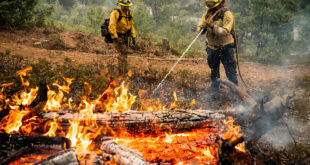These triple digit temperatures can take a toll on people with asthma and respiratory issues.
Dr. A.M. Aminian from the Allergy Institute stopped by KSEE Sunrise with some tips on how to beat the heat for people with and without asthma.
Take It Easy…
On really hot days even regular activity can feel strenuous and cause asthma symptoms. If possible, schedule outdoor activities in the early morning or late evening. Stay inside where it’s cool as much as possible. When at home or in the car keep windows closed and the air conditioning on. So, go see a movie, or visit the library and stay cool.
Things to look for when it’s hot!
Heat Exhaustion: Heat exhaustion happens when you cannot sweat enough to cool your body. It generally occurs when someone is working or exercising in hot weather, sweats a lot, and does not drink enough liquids to replace lost fluids. Heat exhaustion is caused by dehydration and/or a loss of electrolytes.
— Symptoms of heat exhaustion include fatigue, weakness, headache, dizziness, nausea, vomiting, decreased coordination, possible fainting, profuse sweating, normal or slightly elevated body temperature, and a possible drop in blood pressure, less than 90 systolic.
Prevention/Treatment: To prevent heat exhaustion, make sure you drink plenty of water and/or sports drink before, during, and after running. If you suffer some signs and symptoms of heat exhaustion, immediately get to a cool place and rest. Drink water and sports drink and if your blood pressure drops below 90 systolic, call 911. Avoid activity for at least 24 hours and refrain from running or exercising in the heat for at least one week.
Heatstroke: Is a very serious medical emergency. It occurs when the body fails to regulate its own temperature and body temperature continues to rise. Heatstroke can develop when a person is working or exercising in a hot environment. They may sweat profusely, but the body still produces more heat than it can lose, which causes the body’s temperature to rise to high levels. Other things that can lead to heatstroke include older age, dehydration, obesity, wearing heavy clothing, running in the heat when you have an infection or fever, not being acclimated to the heat, high blood pressure, and certain medications like amphetamines, diuretics, and beta blockers.
— Symptoms heatstroke include a high body temperature (106 or higher), lack of sweating, red and dry skin, altered consciousness, confusion, convulsions (seizures), moderate to severe difficulty breathing, and a fast heart rate.
Prevention/Treatment: Heatstroke can cause severe dehydration and can cause body organs to stop functioning. Heatstroke is a life-threatening medical emergency and if you suffer any signs or symptoms, call 9-1-1 immediately. Rest in a cool place, remove clothing to expose your skin to the air, and apply ice packs or cool water to the groin, underarms, and neck until help arrives.
Stay Hydrated: If outdoors, drink plenty of fluid, don’t allow yourself to overheat.
Be Wise Before Going…
For Asthma suffers using your quick-relief inhaler 15 – 30 minutes before going outside in the heat or exercising will help avoid asthma symptoms. Asthma medicines only work if you use them the right way.
Click here to check your local air quality.
Go Fragrance-Free: Sunscreens, tanning lotion, bug spray and citronella candles all have fragrances that can worsen asthma symptoms. Choose products that are unscented and lotions instead of aerosol sprays.
 Mariposa Fire Mountain Community Fire Information
Mariposa Fire Mountain Community Fire Information

Wanna Comment?